Stepintime (talk | contribs) Tags: Visual edit apiedit |
mNo edit summary |
||
| (26 intermediate revisions by 3 users not shown) | |||
| Line 1: | Line 1: | ||
| − | {{ |
+ | {{Under Construction|timeline = Russian America}} |
{{clear}} |
{{clear}} |
||
[[File:INTLBUD-photo-1.jpg|thumb|right|The International Buddhist Temple in {{RA|New Westminster}}, {{RA|Columbia}}.]] |
[[File:INTLBUD-photo-1.jpg|thumb|right|The International Buddhist Temple in {{RA|New Westminster}}, {{RA|Columbia}}.]] |
||
| − | '''{{W|Buddhism}} in {{RA|Alaska}}''' ({{lang|Russian}}: буддизм |
+ | '''{{W|Buddhism}} in {{RA|Alaska}}''' ({{lang|Russian}}: буддизм на Аляске, ''buddizm na Alyaske'') is currently the third largest {{W|religion}} within the nation, making up roughly 10% of the population. Prior to the {{W|1950s}}, the majority of Alaskan Buddhists had immigrated from the predominantly Buddhist areas of the {{RA|Russian Empire}} (all of which followed the teachings of {{W|Tibetan Buddhism}}). Since then, a blend of Buddhist teachings with {{W|Ethnic groups in Europe|European}} and {{W|Indigenous peoples of the Americas|Indigene}} culture have culminated into an Alaskan-oriented school known as "New World Buddhism" (Новосветский буддизм, ''Novosvyetskiy buddizm''). |
Geographically speaking, Alaskan Buddhists are distributed throughout all of Alaska. The vast majority are clustered within the southernmost {{RA|Governorates of Alaska|governorates}}. The cities of {{RA|New Westminster}}, {{RA|Ross}}, and {{RA|Vladikaskady}} currently have the largest percentage of Alaskan Buddhists. |
Geographically speaking, Alaskan Buddhists are distributed throughout all of Alaska. The vast majority are clustered within the southernmost {{RA|Governorates of Alaska|governorates}}. The cities of {{RA|New Westminster}}, {{RA|Ross}}, and {{RA|Vladikaskady}} currently have the largest percentage of Alaskan Buddhists. |
||
| Line 11: | Line 11: | ||
=== Early Colonialism === |
=== Early Colonialism === |
||
| − | {{W|Buddhism}} was first introduced to {{RA|Alaska}} (then part of the {{RA|Russian Empire}}) during the early {{W|19th Century}} by {{W|Kalmyk people|Kalmyk soldiers}} serving in the {{RA| |
+ | {{W|Buddhism}} was first introduced to {{RA|Alaska}} (then part of the {{RA|Russian Empire}}) during the early {{W|19th Century}} by {{W|Kalmyk people|Kalmyk soldiers}} serving in the {{RA|Great Western War}}. On one such occasion before a battle against {{RA|Spain|Spanish forces}}, the Kalmyks would construct a {{W|bodhisattva}} and meditate. According to legend, this gesture of piety assured the victory of the Russian Empire throughout the war. During the early wave of Russian colonization into {{RA|Russian America}}, a significant number of Kalmyks chose to follow. Despite the large number of emigrants, the {{W|clergy}} and other Buddhist officials were reluctant to leave their spiritual homelands. {{W|Arkad Chubanov|Roman Manzhikov}}<!--Роман Манжиков--> (a rural Kalmyk baksha) was among those who advocated the expansion of Buddhist teachings beyond their homelands. Manzhikov became the first leader arrive in Russian America and orchestrated the construction of Alaska's first {{W|monastery}} in {{RA|Sonoma}}. His teachings emphasized {{W|generosity}}, {{W|scholasticism}}, and {{W|Family|family kinship}} as vehicles most important to successful {{W|meditation}}. Manzhikov's nephew, {{W|Arkad Chubanov}}<!--Аркад Чубанов-->, would continue his uncle's desire to relocate Kalmyks to Sonoma. [[File:Lama arkad Kalmyk.jpg|left|thumb|281x281px|Arkad Chubanov, second Alaskan Lama 1872-1894]] |
| − | Traditionally, students hoping to achieve {{W|Priest|priesthood}} would need to travel to {{RA|Tibet}} for their training. As this had become impractical |
+ | Traditionally, students hoping to achieve {{W|Priest|priesthood}} would need to travel to {{RA|Tibet}} for their training. As this had become impractical in {{RA|Russian America}}, new spiritual grounds were establish in {{RA|Sonoma}}. Places for meditation were also established in {{RA|Oregon}} most famously {{W|Crater Lake}}, where students would spend parts of their year in relative solitude in order to achieve {{W|Nirvana|enlightenment}} (a practice which many {{W|Tibetan Buddhism|Lamaists}} continue to this day). |
Contact between the {{W|Kalmyk people|Kalmyks}} and {{W|Alaska Natives|Native Alaskans}} has been recorded throughout the early {{W|19th Century}}. Early relations ranged from co-operative to hostile, Despite these early periods, {{W|Buddhism}} was picked-up by several tribes in central and southern Alaska. Sightings of {{W|totem pole}}s incorporating Buddhist themes were reported as early as 1850. The {{W|California Gold Rush|Gold Rush}} of the 1850s would see a new wave of {{W|Asian people|Asian immigration}}, with {{W|Han Chinese}} constituting the largest group. Though the majority intended to return to {{RA|China}} after securing riches, a significant number of Chinese immigrants chose to permanently settle in {{RA|Russian America}} and {{RA|Columbia|British Columbia}}. {{W|Buryats}}, {{W|Manchu people|Manchus}}, {{W|Mongols}}, and {{W|Tuvans}} soon followed. {{W|Chan Buddhism}} was introduced and soon overtook the {{W|Tibetan Buddhism|Tibetan schools}} which had been established by the Kalmyk colonists. |
Contact between the {{W|Kalmyk people|Kalmyks}} and {{W|Alaska Natives|Native Alaskans}} has been recorded throughout the early {{W|19th Century}}. Early relations ranged from co-operative to hostile, Despite these early periods, {{W|Buddhism}} was picked-up by several tribes in central and southern Alaska. Sightings of {{W|totem pole}}s incorporating Buddhist themes were reported as early as 1850. The {{W|California Gold Rush|Gold Rush}} of the 1850s would see a new wave of {{W|Asian people|Asian immigration}}, with {{W|Han Chinese}} constituting the largest group. Though the majority intended to return to {{RA|China}} after securing riches, a significant number of Chinese immigrants chose to permanently settle in {{RA|Russian America}} and {{RA|Columbia|British Columbia}}. {{W|Buryats}}, {{W|Manchu people|Manchus}}, {{W|Mongols}}, and {{W|Tuvans}} soon followed. {{W|Chan Buddhism}} was introduced and soon overtook the {{W|Tibetan Buddhism|Tibetan schools}} which had been established by the Kalmyk colonists. |
||
| Line 20: | Line 20: | ||
Despite the level of {{W|racism}} which existed between {{W|Asian people|Asian}} and {{W|Ethnic groups in Europe|European}} colonists, {{W|Buddhism}} within {{RA|Russian America}} would see its expansion beyond Asian colonists. Many of these {{W|Russians|Russian}} converts would incorporate some of their own interpretations, which would later form the basis of New World Buddhism ({{lang|Russian}}: Новосветский буддизм, ''Novosvetsky buddizm''). Russian-born scholar, {{W|Fyodor Shcherbatskoy}}, took personal interest in this development and traveled to Russian America at the turn of the {{W|20th Century}} (along with others). New World Buddhism would eventually add more elements which were designed to make the religion more palatable to former {{W|Christianity|Christians}}. By 1900, there were more than 200 temples and dozens of monasteries across Russian America. {{W|Alaska Natives|Native Alaskans}} increasingly converted to Buddhism as an alternative to the forced {{W|Christianization}} of the English and Russian colonizers. |
Despite the level of {{W|racism}} which existed between {{W|Asian people|Asian}} and {{W|Ethnic groups in Europe|European}} colonists, {{W|Buddhism}} within {{RA|Russian America}} would see its expansion beyond Asian colonists. Many of these {{W|Russians|Russian}} converts would incorporate some of their own interpretations, which would later form the basis of New World Buddhism ({{lang|Russian}}: Новосветский буддизм, ''Novosvetsky buddizm''). Russian-born scholar, {{W|Fyodor Shcherbatskoy}}, took personal interest in this development and traveled to Russian America at the turn of the {{W|20th Century}} (along with others). New World Buddhism would eventually add more elements which were designed to make the religion more palatable to former {{W|Christianity|Christians}}. By 1900, there were more than 200 temples and dozens of monasteries across Russian America. {{W|Alaska Natives|Native Alaskans}} increasingly converted to Buddhism as an alternative to the forced {{W|Christianization}} of the English and Russian colonizers. |
||
[[File:Cherbatskoy.jpg|thumb|205x205px|Fyodor Shckerbatskoy, one on the first Russian Alaskan Buddhists . ]] |
[[File:Cherbatskoy.jpg|thumb|205x205px|Fyodor Shckerbatskoy, one on the first Russian Alaskan Buddhists . ]] |
||
| − | During the {{RA|Russo-Japanese War}}, the {{RA|Russian Empire|Imperial authorities}} grew suspicious of all {{W|Buddhism|Buddhists}}. Fears of "{{RA|Japan|Japanese Sabotage}}" spurred the adoption of restrictive laws and the conversion of many Buddhists to {{W|Eastern Orthodox Church|Eastern Orthodoxy}}. The conclusion of the war and Russia's expansion into {{RA|Manchuria}} saw a short boom of new {{W|Asian people|Asian immigrants}}. As new technologies became available for {{RA|Russian America}} |
+ | During the {{RA|Russo-Japanese War}}, the {{RA|Russian Empire|Imperial authorities}} grew suspicious of all {{W|Buddhism|Buddhists}}. Fears of "{{RA|Japan|Japanese Sabotage}}" spurred the adoption of restrictive laws and the conversion of many Buddhists to {{W|Eastern Orthodox Church|Eastern Orthodoxy}}. The conclusion of the war and Russia's expansion into {{RA|Manchuria}} saw a short boom of new {{W|Asian people|Asian immigrants}}. As new technologies became available for {{RA|Russian America|Russian Americans}}, many second and third generation Buddhists were able to see Asia for the first time and returning with new artifacts and texts. This period of Alaskan history would be a time of spiritual renewal for Buddhists. {{W|Tibetan Buddhism|Lamaists}} would go to great lengths to retrieve artifacts back to Russian America, while others would travel on pilgrimages to holy sights in {{W|Nepal}} and {{RA|Tibet}}. Many would return with a certain level of orthodoxy that differed from other Buddhist movements at the time. |
=== The Alaskan Wars === |
=== The Alaskan Wars === |
||
| Line 28: | Line 28: | ||
based one's local political environment and the best way for estranged minorities to avoid being targeted by majority white {{W|Christian|Christian}} populations or [[ Alaskan Socialist Republic (Russian America)|communist vanguards]]. In 1922 communists in [[New Irkutsk (Russian America)|New Irkutsk]] and the [[Far North (Russian America)|Far North]] issues edicts forcing Buddhists to renounce their faith or face expulsion. Most able bodied men were forcibly drafted into {{W|Bolshevik}} armies or faced with imprisonment. Between 1919 and 1923 - At least fifty temples were destroyed and many communities were dispersed. Hundreds were sent to labor camps for re-education throughout the 1930's, some Buddhist prisoners were imported<nowiki> </nowiki>from the [[Soviet Union (Russian America)|Soviet Union]]. |
based one's local political environment and the best way for estranged minorities to avoid being targeted by majority white {{W|Christian|Christian}} populations or [[ Alaskan Socialist Republic (Russian America)|communist vanguards]]. In 1922 communists in [[New Irkutsk (Russian America)|New Irkutsk]] and the [[Far North (Russian America)|Far North]] issues edicts forcing Buddhists to renounce their faith or face expulsion. Most able bodied men were forcibly drafted into {{W|Bolshevik}} armies or faced with imprisonment. Between 1919 and 1923 - At least fifty temples were destroyed and many communities were dispersed. Hundreds were sent to labor camps for re-education throughout the 1930's, some Buddhist prisoners were imported<nowiki> </nowiki>from the [[Soviet Union (Russian America)|Soviet Union]]. |
||
[[File:Deportation.jpg|left|thumb|220x220px|Deportation of Buddhists from a monastery to {{RA|Nooshagak}} in the [[Alaskan Socialist Republic (Russian America)|Alaskan Socialist Republic]] in 1922. ]] |
[[File:Deportation.jpg|left|thumb|220x220px|Deportation of Buddhists from a monastery to {{RA|Nooshagak}} in the [[Alaskan Socialist Republic (Russian America)|Alaskan Socialist Republic]] in 1922. ]] |
||
| − | Old World destruction of Buddhist culture led to massive Buddhist white emigres, perhaps as many of 100,000 by 1930. Many came willing to fight for the Alaskan National Republic and English Colombia but faced suspicion from <nowiki> </nowiki>both. A.N.R fighters believed {{w|Asian People|Asiatic refugees}} could be infiltrated with red agents and often barred them from jobs and military service.[[Columbia (Russian America)| Columbians]] closed their border to the emigres, and sectioned off <nowiki> </nowiki>existing Buddhist communities from mainstream life. |
+ | Old World destruction of Buddhist culture led to massive Buddhist white emigres, perhaps as many of 100,000 by 1930. Many came willing to fight for the Alaskan National Republic and English Colombia but faced suspicion from <nowiki> </nowiki>both. A.N.R fighters believed {{w|Asian People|Asiatic refugees}} could be infiltrated with red agents and often barred them from jobs and military service. The {{RA|English Alaskans|English}} state of {{RA|Commonwealth of Columbia|Columbia}} classified Buddhists as cultural enemies of the state. [[Columbia (Russian America)| Columbians]] closed their border to the emigres, and sectioned off <nowiki> </nowiki>existing Buddhist communities from mainstream life. |
| − | Fortunately, the [[Alaskan Democratic Republic (Russian America)|Alaskan Democratic Republic]] that replaced the A.N.R took a more forgiving position of Buddhists, the A.D.R saw the need to incorporate minorities for the sake of unity. Buddhists were brought back into public life to some extent and were permitted entrance into military service and some government |
+ | Fortunately, the [[Alaskan Democratic Republic (Russian America)|Alaskan Democratic Republic]] that replaced the A.N.R took a more forgiving position of Buddhists, the A.D.R saw the need to incorporate minorities for the sake of unity. Buddhists were brought back into public life to some extent and were permitted entrance into military service and some government employment. For this reason {{RA|Sitka}} still hosts some of the largest Buddhist minorities by percentage in Alaska today. |
| − | Buddhist Alaskans found their Alaskan identity in supporting the unification of all of Russian America. In the {{W|1930's|1930's}} several Buddhist Monks become well known in the general mainstream for their calls for pacifism. |
+ | Buddhist Alaskans found their Alaskan identity in supporting the unification of all of Russian America. In the {{W|1930's|1930's}} several Buddhist Monks become well known in the general mainstream for their calls for pacifism. [[Sonoma (Russian America)|Sonoma]] saw a generation of Middle class of Russian-speaking Buddhist Entrepreneurs, Educators, Doctors and Lawyers became better known in the coastal cities. Buddhist sponsored Schools, businesses and clinics became common. While this by itself strengthened the economic power of Buddhists many Buddhists converted to {{W|Eastern Orthodox Church|Russian Orthodoxy}} to further assimilate into the Alaskan identity. |
=== In Independent Alaska === |
=== In Independent Alaska === |
||
| − | The reunification of <nowiki> </nowiki>Alaska in 1942 led to official recognition of Buddhists right to religious freedom everywhere in {{RA|Alaska}} in 1944. The rise of university education for the next twenty years piked more interest in Buddhism by the general Alaskan population. From the early 50's New World Buddhism became popular in Alaskan Youth as it was molded by students at public universities. Elements such as Buddha idols and prayer flags became mainstream elements of youth pop culture. Buddhism benefited in the 1960's by |
+ | The reunification of <nowiki> </nowiki>Alaska in 1942 led to official recognition of Buddhists right to religious freedom everywhere in {{RA|Alaska}} in 1944. The rise of university education for the next twenty years piked more interest in Buddhism by the general Alaskan population. From the early 50's New World Buddhism became popular in Alaskan Youth as it was molded by students at public universities. Elements such as Buddha idols and prayer flags became mainstream elements of youth pop culture. Buddhism benefited in the 1960's by anti discrimination laws in the work place and schools enacted by the {{RA|Vasily Kardash|Kardash administration}}. Monasteries in this period were particularly active in bringing teachers and major saintly figures from the {{RA|Soviet Union}} to liberate them from {{W|State Atheism.}} |
| − | [[File:Student Buddhists.JPG|thumb|225x225px| |
+ | [[File:Student Buddhists.JPG|thumb|225x225px|An Alaskan African student and a monk at [[New Westminster (Russian America)|New Westminster]] University of Philosophy, 1965 ]] |
| − | The 1960's and 1970's saw Buddhists split on racial lines segments of {{W|Asian Americans|Asian Alaskans}} switched out |
+ | The 1960's and 1970's saw Buddhists split on racial lines segments of {{W|Asian Americans|Asian Alaskans}} switched out and many whites joined existing groups or made new organizations. Asians who remained Buddhist increasingly united with each other to preserve their heritage. White Buddhists were generally more interested in combining meditation with {{W|New Age|New Age Spirituality}}. Older Asiatic laymen stiffened with {{W|Conservatism}} as diverse youth became more impassioned with their beliefs. Certain organizations tilted towards recent immigrants while others catered to students and unconventional philosophers. One central issue that threatened to split the Buddhist community was the status of women, historically women in Buddhism could not achieve {{W|Nirvana}} in the female form. Within organizations some students and nuns demanded that doctrine embrace equal spirituality for women. <nowiki> </nowiki>and to renounce the concept that {{W|Femininity|feminity}} was a result of bad {{W|Karma}} were fundamentally equal both in material and spiritual matters. Alienating the Church from other Buddhists. Hundreds of young pupils were expelled from other established organizations when demands for similar changes came to a head. The enthusiastic Buddhist youth also provoked suspicion from {{W|Eastern Orthodox Church|Russian Orthodoxy}}. |
=== New Developments === |
=== New Developments === |
||
| − | By 1985 divisions threatened to unravel the entire Buddhist community, a sizable but fragile Alaskan minority |
+ | By 1985 divisions threatened to unravel the entire Buddhist community, a sizable but fragile Alaskan minority. In [[Vladikaskady (Russian America)|Vladikaskady]] a conference between the <nowiki> </nowiki>the largest organizations and monasteries tried to resolve the differences in practices and doctrine with limited success. Afterwards,<nowiki> </nowiki>open division subsided but participation and membership in institutions slumped.While still an important cornerstone toward Asian Alaskans, Buddhism in Alaska was no longer for Asians alone as they shared their faith alongside Europeans and Native Alaskans.. |
[[File:01 IMG 0087 Tatar Kalmyk.jpg|thumb|220x220px|A Lamnaist and a New Worldist at the 1985 Validkaday All Buddhist Conference |left]]The dissolution of the Soviet Union brought the most recent surge in Buddhist from Eurasia, <nowiki> </nowiki>of both laymen and practitioners. Many people from {{W|Buryatia}}, {{W|Mongolia}}, {{W|Kalmakya}}, [[Manchuria (Russian America)|Manchuria]] and other nations had freedom of movement for the first time since the founding of the USSR. Arriving to Alaska in the 90's immigrants arguably brought Alaskan Buddhism closer back to the {{W|Mahayana Buddhism}} of {{W|Asia}}. The immigration has spurred the construction of several new projects. Such as the Tseveer Gegeerel monastery recently finished in 2011. The first fifteen years of the 21st century continues to see the rise of a spiritually and <nowiki> </nowiki>ethnically diverse movement but still retaining unity in impact on all of Alaskan society. |
[[File:01 IMG 0087 Tatar Kalmyk.jpg|thumb|220x220px|A Lamnaist and a New Worldist at the 1985 Validkaday All Buddhist Conference |left]]The dissolution of the Soviet Union brought the most recent surge in Buddhist from Eurasia, <nowiki> </nowiki>of both laymen and practitioners. Many people from {{W|Buryatia}}, {{W|Mongolia}}, {{W|Kalmakya}}, [[Manchuria (Russian America)|Manchuria]] and other nations had freedom of movement for the first time since the founding of the USSR. Arriving to Alaska in the 90's immigrants arguably brought Alaskan Buddhism closer back to the {{W|Mahayana Buddhism}} of {{W|Asia}}. The immigration has spurred the construction of several new projects. Such as the Tseveer Gegeerel monastery recently finished in 2011. The first fifteen years of the 21st century continues to see the rise of a spiritually and <nowiki> </nowiki>ethnically diverse movement but still retaining unity in impact on all of Alaskan society. |
||
== Variants == |
== Variants == |
||
| Line 49: | Line 49: | ||
==== '''Lamaism''' ==== |
==== '''Lamaism''' ==== |
||
[[File:Dsc 6274.jpg|left|thumb|225x225px|A meditating Lamanist woman in [[Ross (Russian America)|Ross]].]] |
[[File:Dsc 6274.jpg|left|thumb|225x225px|A meditating Lamanist woman in [[Ross (Russian America)|Ross]].]] |
||
| − | A school Based out of Tibet, Lamaism has historically been the primary faith of the {{W|Mongol People|Mongol}}, {{W|Buryats|Buryat,}} {{W|Manchu People|Manchurian}} and other {{W|Tungusic Peoples|Siberian Alaskans}}.In contrast to the {{W|Old World}} Alaskan Lamaism has begun to use Mongol in addition to Tibetan as a holy language. Due to early Kalmyk inroads into Alaska a certain portion of Native Americans are also affiliated with Lamaism. While other schools have emerged in recent years the {{W|Geluge|Gelug school}} was traditionally the prominent School and still holds |
+ | A school Based out of Tibet, Lamaism has historically been the primary faith of the {{W|Mongol People|Mongol}}, {{W|Buryats|Buryat,}} {{W|Manchu People|Manchurian}} and other {{W|Tungusic Peoples|Siberian Alaskans}}.In contrast to the {{W|Old World}} Alaskan Lamaism has begun to use Mongol in addition to {{W|Tibetan Language|Tibetan}} as a holy language. Due to early Kalmyk inroads into Alaska a certain portion of Native Americans are also affiliated with Lamaism. While other schools have emerged in recent years the {{W|Geluge|Gelug school}} was traditionally the prominent School and still holds sway. Lamnists in Alaska have their own spiritual head independent from the spiritual head of the Tibet. However Lamnists in Alaska still give official acknowledgment to the {{W|Dalai Lama|Tibetan Dalai Lama}} as the reincarnation of the Bodhisattva of compassion but not as the political leader he is in Tibet. Recently with the rise of globalization the Alaskan Lamnists are working on forging closer spiritual ties with [[Tibet (Russian America)|Tibet]] to enrich study and debate in Alaska. Since 1990 Lamnists from both countries have sent missions of monks and masters to each other to engage in group meditation and discussion in annual Lotus gatherings. |
==== '''Chan and Zen''' ==== |
==== '''Chan and Zen''' ==== |
||
| Line 56: | Line 56: | ||
==== '''New World Buddhism''' ==== |
==== '''New World Buddhism''' ==== |
||
| − | [[File:Fallingwater - DSC05639.JPG|left|thumb| |
+ | [[File:Fallingwater - DSC05639.JPG|left|thumb|300x300px|Little Step Meditation Center, [[Oregon (Russian America)|Oregon Governate,]] ]] |
| ⚫ | New World Buddhism''' '''is a unique result of cultural fusing and characterizes many beliefs and ideas native to Alaska. Arising from the {{W|19th Century|19th century}} writings of European, Asians and native Americans that met each other in Alaska. New World Buddhism emphasizes the {{W|Western Hemisphere}}. New World Buddhists believe there is innocence in the Americas because it is more pristine and untarnished, and was cared for by natives prior to {{W|European Colonization of the Americas|colonization}}. As a result New World Buddhists believe nature must be kept as pure as possible and are fervent environmentalists. Native influence is confirmed by the use of totem poles, masks and native drums as objects of meditation in the [[Yakutat (Russian America)|Yakutat governate]] Teachings prescribe the merging between human and the wild as a facilitator for the reduction of suffering. Rivers and trees are particularly sacred in accomplishing personal peace. In contrast to other sects New World Buddhists are not as interested in elaborate temples but favor open spaces where laymen can reach consciousness. New World architecture tends to be minimalist and seeks to match any sacred structures with the surrounding environment. This is the case with Little Step Meditation Center in [[Oregon (Russian America)|Oregon]] which is built to stream with existing river flow. New World Buddhism has been classified as "westernized" by Buddhists and secular intellectuals because of its public nature encouraging congregations of followers and preaching like Christianity. Controversially some New World priests have suggested the {{W|Comparison of Buddhism and Christianity|Buddha hood of Jesus Christ}}. However most major New World Buddhist organizations publicly reject any linking between {{W|Buddha}} and {{W|Jesus}}. |
||
| − | New World Buddhism''' '''is a unique result of cultural fusing and characterizes many beliefs and ideas native to Alaska. Arising from the {{W|19th Century|19th century}} |
||
| ⚫ | |||
| − | |||
| − | Controversially some New World priests have suggested the {{W|Comparison of Buddhism and Christianity|Buddha hood of Jesus Christ}}. However most major New World Buddhist organizations publicly reject any linking between {{W|Buddha}} and {{W|Jesus}}. |
||
| − | |||
== Organizations == |
== Organizations == |
||
| Line 68: | Line 64: | ||
==== Enlightenment Church, ==== |
==== Enlightenment Church, ==== |
||
[[File:Young American Buddhists .jpg|thumb|192x192px|A youth Enlightenment Church delegation ]] |
[[File:Young American Buddhists .jpg|thumb|192x192px|A youth Enlightenment Church delegation ]] |
||
| − | The '''Enlightenment Church '''(Russian: просветление церковь, ''prosvetleniye tserkov''), is the largest organization supporting New World Buddhism thought and belief. Founded in 1955, the church claims to have 120,000 members in Alaska and 150,000 total world wide. Beginning as a youth movement the Enlightenment Church opposed hierarchy in principal but has since developed central organization to maintain cohesion. Presently the structure is similar to the Orthodox Church but the Enlightenment Church is ruled by a counsel of eight ministers instead of a patriarchy. Each minister represents a part of the |
+ | The '''Enlightenment Church '''(Russian: просветление церковь, ''prosvetleniye tserkov''), is the largest organization supporting New World Buddhism thought and belief. Founded in 1955, the church claims to have 120,000 members in Alaska and 150,000 total world wide. Beginning as a youth movement the Enlightenment Church opposed hierarchy in principal but has since developed central organization to maintain cohesion. Presently the structure is similar to the Orthodox Church but the Enlightenment Church is ruled by a counsel of eight ministers instead of a patriarchy. Each minister represents a part of the {{W|Noble Eigthfold Path Buddhist}} moral code. Sometimes the church has been termed an "activist" organization due to its congregations efforts to campaign against animal testing and fur coats. The issue of fur coats is controversial within the church as the fur trade still remains important to the Alaskan economy and consumers. |
The Enlightenment Church is currently active in 30 countries and is present in every other country in North America. Notably the Enlightenment Church has a high percentage of white members. |
The Enlightenment Church is currently active in 30 countries and is present in every other country in North America. Notably the Enlightenment Church has a high percentage of white members. |
||
| Line 74: | Line 70: | ||
==== Assembly of the Eastern Lama ==== |
==== Assembly of the Eastern Lama ==== |
||
[[File:Kalmyk Lama.jpg|thumb|309x309px|The current Kalmyk Lama (right) at a press conference. |left]] |
[[File:Kalmyk Lama.jpg|thumb|309x309px|The current Kalmyk Lama (right) at a press conference. |left]] |
||
| − | The '''Assembly of the Lama''' (Russian: Ассамблея ламы, assambleya lamy, (Mongolian:Ламын Ассамблей,''Lamyn Assamblyei'') formally known as the Yellow Hat Dharma is the central organization for Lamnists in Alaska. Founded in 1885 as a linking of Kalmyk and other immigrant communities. Centered around the "Eastern Lama" , or the lama east of Tibet. Traditionally until the turn of the century most |
+ | The '''Assembly of the Lama''' (Russian: Ассамблея ламы, assambleya lamy, (Mongolian:Ламын Ассамблей,''Lamyn Assamblyei'') formally known as the Yellow Hat Dharma is the central organization for Lamnists in Alaska. Founded in 1885 as a linking of Kalmyk and other immigrant communities. Centered around the "Eastern Lama" , or the lama east of Tibet. Traditionally until the turn of the century most {{W|Mongolic Languages|Mongolic}} newborns were registered with the Assembly. In times of domestic crisis the Assembly takes part in disaster relief for all Alaskans and coordinates with the Red Wheel. The Assembly holds a chain of schools, monasteries, temples, libraries a university and many charities. With 100,000 active members and 400,000 non active members the Assembly has been one of the most visible images of Buddhist and Asian Alaskans to general mainstream. The Eastern Lama, is one of the most influential of Asian Alaskans today appearing regularly by the televised media to give the "Buddhist" or mistakenly the "Asiatic" view on major events. |
==== Gusku Society ==== |
==== Gusku Society ==== |
||
[[File:Gusku Society fire ritual.jpg|thumb|220x220px|Fire ritual in honor of a reincarnated enlightened chief, [[ Sonoma (Russian America)|Sonoma Governate ]] ]] |
[[File:Gusku Society fire ritual.jpg|thumb|220x220px|Fire ritual in honor of a reincarnated enlightened chief, [[ Sonoma (Russian America)|Sonoma Governate ]] ]] |
||
| − | The '''Gusku Society '''(Mongolian:Ламын Ассамблей, ''Gusku Niigem'') emerged after early contact between the Pomo tribe and Kalmyk people. In recent years the Gusku Society has become more of a functioning organization among native elders, adapting certain Buddhist beliefs to their existing religion. Named after "'''Gusku'''" an old Pomo deity, the word "society" refers to loose organization of holy men among many native American tribes in Southern Alaska. From at least 1900 many of the Pomo have identified Gusku as being a god that became a Buddha. Old precolonial rites are still practiced under the guise of Buddhism. |
+ | The '''Gusku Society '''(Mongolian:Ламын Ассамблей, ''Gusku Niigem'') emerged after early contact between the {{W|Pomo people|Pomo tribe}} and {{W|Kalmyk people}}. In recent years the Gusku Society has become more of a functioning organization among native elders, adapting certain Buddhist beliefs to their existing religion. Named after "'''Gusku'''" an old Pomo deity, the word "society" refers to loose organization of holy men among many native American tribes in Southern Alaska. From at least 1900 many of the Pomo have identified Gusku as being a god that became a {{W|Buddha (title)|Buddha}}. Old precolonial rites are still practiced under the guise of Buddhism. |
| + | |||
| + | Almost all of the members are native Alaskans with the exception of a few Kalmyks and Slavs. The Gusku Society also cooperates with sister branches from the {{W|Aleut}}, {{W|Inuit}} and {{W|Tinglit}}, all of which combine Buddhism with their separate native traditions. The Tinglit have become famous for their dozens of totem poles that combine {{W|Alaska Native Religion|Indian religion}} with Buddhist teachings, these totem poles are mostly seen outside of Gusku Society centers and have become a tourist attraction in their own right. |
||
=== Schools === |
=== Schools === |
||
==== University of Manchicov ==== |
==== University of Manchicov ==== |
||
| − | Founded in 1975 the '''University of Manchicov''' is a private non for profit university in [[Ross (Russian America)|Ross]],[[Sonoma (Russian America)|Sonoma]]. The largest accredited Buddhist institution of higher learning in Alaska. Founded officially to facilitate a richer traditional Buddhist community and to equip that community for the modern economy, the University of Nemev has developed a global reputation for its medical and electronic |
+ | Founded in 1975 the '''University of Manchicov''' is a private non for profit university in [[Ross (Russian America)|Ross]],[[Sonoma (Russian America)|Sonoma]]. The largest accredited Buddhist institution of higher learning in Alaska. Founded officially to facilitate a richer traditional Buddhist community and to equip that community for the modern economy, the University of Nemev has developed a global reputation for its medical and electronic development departments. Other prestigious programs are the departments of {{W|Buddhism|Buddhist Theology}}, {{W|Eurasian History|Eurasian History}}, and {{W|Altaic languages|Northeast Asian languages}}. Through the 1980's and 90's the University of Manchicov was the fastest growing college in the country superseding older Buddhist campuses. The University of Manchivcov is home to the largest library of Asiatic literature and history in the Americas.Today the university has become to be the most prestigious vehicle for entering the Buddhist Clergy. Hosting 15,000 undergraduates 20% of the student body is international. Adjacent to the University is a monastery with several hundred monks and graduate students reside. The University is named in honor Roman Manchicov, one of the first Buddhists to arrive in Alaska during [[Russian America (Russian America)|colonial times]]. |
=== Associated Symbols === |
=== Associated Symbols === |
||
==== Red Wheel ==== |
==== Red Wheel ==== |
||
| − | The Red Wheel is a symbol used by the {{W|International Association of Red Cross and Crescent societies|International Association of Cross Societies}} the symbol was used for the first time by Alaskan Buddhist volunteers in several 19th century and 20th century conflicts. Inspired by the {{W|Dharma}} wheel volunteers began to use the symbol to reach wounded soldiers and civilians who had little familiarity with {{W|Christianity}} or {{W|Islam}}. While Buddhists had also used the {{W|Red Swastika Society|Red Swastika}} before the 1940's this was entirely replaced by the Red Wheel to remove any possible confusion with the swastika of {{W|Nazism}}. Since {{W|World War II}} the Red Wheel is most commonly seen in nations |
+ | The Red Wheel is a symbol used by the {{W|International Association of Red Cross and Crescent societies|International Association of Cross Societies}} the symbol was used for the first time by Alaskan Buddhist volunteers in several 19th century and 20th century conflicts. Inspired by the {{W|Dharma}} wheel volunteers began to use the symbol to reach wounded soldiers and civilians who had little familiarity with {{W|Christianity}} or {{W|Islam}}. While Buddhists had also used the {{W|Red Swastika Society|Red Swastika}} before the 1940's this was entirely replaced by the Red Wheel to remove any possible confusion with the swastika of {{W|Nazism}}. Since {{W|World War II}} the Red Wheel is most commonly seen in nations without a {{W|Christianity|Christian}} or {{W|Islam|Islamic}} background. |
== Demography == |
== Demography == |
||
| + | [[File:Map of Buddhism in Alaska (Russian America).png|thumb|220x220px|Concentration of Alaska's Buddhists by governante.From the 2007 Federal Census ]] |
||
| ⚫ | As of 2007 federal Alaskan Census 9.7% of the Alaskan people (5,456,864) |
||
| + | As of 2017 federal Alaskan Census 9.9% of the Alaskan people (6,028,525) claimed to profess affiliation to Buddhism. While birthrates for Buddhist families have fallen in the past ten years a small growth rate has been consistent. In part this small increase is due from a small influx of converts and immigrants from Eurasia. Of these 63% stated they were of Asian Origin, 31% stated they were of white origin, 4% of "Indian" origin and 2% stated "other". Attainment of at least a bachelors or equivalent college degree has expanded to (74%) among adults. |
||
| + | |||
| ⚫ | As of 2007 federal Alaskan Census 9.7% of the Alaskan people (5,456,864)claimed to profess affiliation to Buddhism. Of these 61% stated they were of "Asian origin", 30% stated they were of "white" origin, 6% of "Indian" origin and 3% stated "other". A solid majority of adult Buddhist Alaskans (69%) had at least a bachelors or equivalent college degree, more educated than the average Alaskan population. |
||
According to a study by the Kuzkin think tank Buddhists were solid[[Evergreens (Russian America)| Evergreen]] supporters until the 1960's on account of {{W|Anti-communism}}. Since the election of [[Vasily Kardash (Russian America)|Vasily Kardash]], Buddhists have gradually moved to the [[Movement for Peace and Freedom (Russian America)|Movement for Peace and Freedom]]. |
According to a study by the Kuzkin think tank Buddhists were solid[[Evergreens (Russian America)| Evergreen]] supporters until the 1960's on account of {{W|Anti-communism}}. Since the election of [[Vasily Kardash (Russian America)|Vasily Kardash]], Buddhists have gradually moved to the [[Movement for Peace and Freedom (Russian America)|Movement for Peace and Freedom]]. |
||
| + | |||
| + | == People == |
||
| + | * {{W|Steve Jobs|Stepan<!--Pavlovich--> Dzhobs (Степан Джобс)}} - New World Buddhist. |
||
| + | [[Category:Alaska (Russian America)]] |
||
| + | [[Category:Buddhism]] |
||
| + | [[Category:Religions]] |
||
| + | [[Category:Religion (Russian America)]] |
||
| + | [[Category:Russian America]] |
||
Revision as of 16:29, 15 November 2019
| The following Russian America page is under construction.
Please do not edit or alter this article in any way while this template is active. All unauthorized edits may be reverted on the admin's discretion. Propose any changes to the talk page. |
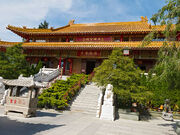
The International Buddhist Temple in New Westminster, Columbia.
Buddhism in Alaska (Russian: буддизм на Аляске, buddizm na Alyaske) is currently the third largest religion within the nation, making up roughly 10% of the population. Prior to the 1950s, the majority of Alaskan Buddhists had immigrated from the predominantly Buddhist areas of the Russian Empire (all of which followed the teachings of Tibetan Buddhism). Since then, a blend of Buddhist teachings with European and Indigene culture have culminated into an Alaskan-oriented school known as "New World Buddhism" (Новосветский буддизм, Novosvyetskiy buddizm).
Geographically speaking, Alaskan Buddhists are distributed throughout all of Alaska. The vast majority are clustered within the southernmost governorates. The cities of New Westminster, Ross, and Vladikaskady currently have the largest percentage of Alaskan Buddhists.
History
Early Colonialism
Buddhism was first introduced to Alaska (then part of the Russian Empire) during the early 19th Century by Kalmyk soldiers serving in the Great Western War. On one such occasion before a battle against Spanish forces, the Kalmyks would construct a bodhisattva and meditate. According to legend, this gesture of piety assured the victory of the Russian Empire throughout the war. During the early wave of Russian colonization into Russian America, a significant number of Kalmyks chose to follow. Despite the large number of emigrants, the clergy and other Buddhist officials were reluctant to leave their spiritual homelands. Roman Manzhikov (a rural Kalmyk baksha) was among those who advocated the expansion of Buddhist teachings beyond their homelands. Manzhikov became the first leader arrive in Russian America and orchestrated the construction of Alaska's first monastery in Sonoma. His teachings emphasized generosity, scholasticism, and family kinship as vehicles most important to successful meditation. Manzhikov's nephew, Arkad Chubanov, would continue his uncle's desire to relocate Kalmyks to Sonoma.
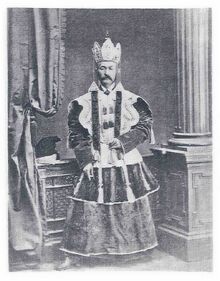
Arkad Chubanov, second Alaskan Lama 1872-1894
Traditionally, students hoping to achieve priesthood would need to travel to Tibet for their training. As this had become impractical in Russian America, new spiritual grounds were establish in Sonoma. Places for meditation were also established in Oregon most famously Crater Lake, where students would spend parts of their year in relative solitude in order to achieve enlightenment (a practice which many Lamaists continue to this day).
Contact between the Kalmyks and Native Alaskans has been recorded throughout the early 19th Century. Early relations ranged from co-operative to hostile, Despite these early periods, Buddhism was picked-up by several tribes in central and southern Alaska. Sightings of totem poles incorporating Buddhist themes were reported as early as 1850. The Gold Rush of the 1850s would see a new wave of Asian immigration, with Han Chinese constituting the largest group. Though the majority intended to return to China after securing riches, a significant number of Chinese immigrants chose to permanently settle in Russian America and British Columbia. Buryats, Manchus, Mongols, and Tuvans soon followed. Chan Buddhism was introduced and soon overtook the Tibetan schools which had been established by the Kalmyk colonists.
Turn of the 20th Century
Despite the level of racism which existed between Asian and European colonists, Buddhism within Russian America would see its expansion beyond Asian colonists. Many of these Russian converts would incorporate some of their own interpretations, which would later form the basis of New World Buddhism (Russian: Новосветский буддизм, Novosvetsky buddizm). Russian-born scholar, Fyodor Shcherbatskoy, took personal interest in this development and traveled to Russian America at the turn of the 20th Century (along with others). New World Buddhism would eventually add more elements which were designed to make the religion more palatable to former Christians. By 1900, there were more than 200 temples and dozens of monasteries across Russian America. Native Alaskans increasingly converted to Buddhism as an alternative to the forced Christianization of the English and Russian colonizers.
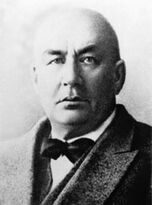
Fyodor Shckerbatskoy, one on the first Russian Alaskan Buddhists .
During the Russo-Japanese War, the Imperial authorities grew suspicious of all Buddhists. Fears of "Japanese Sabotage" spurred the adoption of restrictive laws and the conversion of many Buddhists to Eastern Orthodoxy. The conclusion of the war and Russia's expansion into Manchuria saw a short boom of new Asian immigrants. As new technologies became available for Russian Americans, many second and third generation Buddhists were able to see Asia for the first time and returning with new artifacts and texts. This period of Alaskan history would be a time of spiritual renewal for Buddhists. Lamaists would go to great lengths to retrieve artifacts back to Russian America, while others would travel on pilgrimages to holy sights in Nepal and Tibet. Many would return with a certain level of orthodoxy that differed from other Buddhist movements at the time.
The Alaskan Wars
The outbreak of civil war in the Russian Empire ruptured fledgling Buddhist groups on political lines. Early on Buddhist clergy were reluctant to take any sides but pockets supported the white, blue and red factions. Such decisions were typically based one's local political environment and the best way for estranged minorities to avoid being targeted by majority white Christian populations or communist vanguards. In 1922 communists in New Irkutsk and the Far North issues edicts forcing Buddhists to renounce their faith or face expulsion. Most able bodied men were forcibly drafted into Bolshevik armies or faced with imprisonment. Between 1919 and 1923 - At least fifty temples were destroyed and many communities were dispersed. Hundreds were sent to labor camps for re-education throughout the 1930's, some Buddhist prisoners were imported from the Soviet Union.
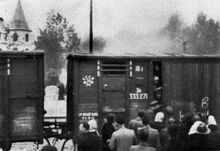
Deportation of Buddhists from a monastery to Nooshagak in the Alaskan Socialist Republic in 1922.
Old World destruction of Buddhist culture led to massive Buddhist white emigres, perhaps as many of 100,000 by 1930. Many came willing to fight for the Alaskan National Republic and English Colombia but faced suspicion from both. A.N.R fighters believed Asiatic refugees could be infiltrated with red agents and often barred them from jobs and military service. The English state of Columbia classified Buddhists as cultural enemies of the state. Columbians closed their border to the emigres, and sectioned off existing Buddhist communities from mainstream life.
Fortunately, the Alaskan Democratic Republic that replaced the A.N.R took a more forgiving position of Buddhists, the A.D.R saw the need to incorporate minorities for the sake of unity. Buddhists were brought back into public life to some extent and were permitted entrance into military service and some government employment. For this reason Sitka still hosts some of the largest Buddhist minorities by percentage in Alaska today.
Buddhist Alaskans found their Alaskan identity in supporting the unification of all of Russian America. In the 1930's several Buddhist Monks become well known in the general mainstream for their calls for pacifism. Sonoma saw a generation of Middle class of Russian-speaking Buddhist Entrepreneurs, Educators, Doctors and Lawyers became better known in the coastal cities. Buddhist sponsored Schools, businesses and clinics became common. While this by itself strengthened the economic power of Buddhists many Buddhists converted to Russian Orthodoxy to further assimilate into the Alaskan identity.
In Independent Alaska
The reunification of Alaska in 1942 led to official recognition of Buddhists right to religious freedom everywhere in Alaska in 1944. The rise of university education for the next twenty years piked more interest in Buddhism by the general Alaskan population. From the early 50's New World Buddhism became popular in Alaskan Youth as it was molded by students at public universities. Elements such as Buddha idols and prayer flags became mainstream elements of youth pop culture. Buddhism benefited in the 1960's by anti discrimination laws in the work place and schools enacted by the Kardash administration. Monasteries in this period were particularly active in bringing teachers and major saintly figures from the Soviet Union to liberate them from State Atheism.
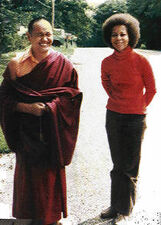
An Alaskan African student and a monk at New Westminster University of Philosophy, 1965
The 1960's and 1970's saw Buddhists split on racial lines segments of Asian Alaskans switched out and many whites joined existing groups or made new organizations. Asians who remained Buddhist increasingly united with each other to preserve their heritage. White Buddhists were generally more interested in combining meditation with New Age Spirituality. Older Asiatic laymen stiffened with Conservatism as diverse youth became more impassioned with their beliefs. Certain organizations tilted towards recent immigrants while others catered to students and unconventional philosophers. One central issue that threatened to split the Buddhist community was the status of women, historically women in Buddhism could not achieve Nirvana in the female form. Within organizations some students and nuns demanded that doctrine embrace equal spirituality for women. and to renounce the concept that feminity was a result of bad Karma were fundamentally equal both in material and spiritual matters. Alienating the Church from other Buddhists. Hundreds of young pupils were expelled from other established organizations when demands for similar changes came to a head. The enthusiastic Buddhist youth also provoked suspicion from Russian Orthodoxy.
New Developments
By 1985 divisions threatened to unravel the entire Buddhist community, a sizable but fragile Alaskan minority. In Vladikaskady a conference between the the largest organizations and monasteries tried to resolve the differences in practices and doctrine with limited success. Afterwards, open division subsided but participation and membership in institutions slumped.While still an important cornerstone toward Asian Alaskans, Buddhism in Alaska was no longer for Asians alone as they shared their faith alongside Europeans and Native Alaskans..
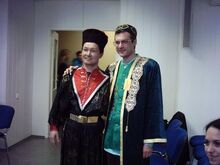
A Lamnaist and a New Worldist at the 1985 Validkaday All Buddhist Conference
The dissolution of the Soviet Union brought the most recent surge in Buddhist from Eurasia, of both laymen and practitioners. Many people from Buryatia, Mongolia, Kalmakya, Manchuria and other nations had freedom of movement for the first time since the founding of the USSR. Arriving to Alaska in the 90's immigrants arguably brought Alaskan Buddhism closer back to the Mahayana Buddhism of Asia. The immigration has spurred the construction of several new projects. Such as the Tseveer Gegeerel monastery recently finished in 2011. The first fifteen years of the 21st century continues to see the rise of a spiritually and ethnically diverse movement but still retaining unity in impact on all of Alaskan society.
Variants
Within Alaskan Buddhism is great diversity relating to practice, teachings and organization. Despite these differences the majority of laymen from all of the major schools have acknowledged each other as fellow Buddhists since the late 1980's. Regardless of their differences all of Alaska's variants agree with the four noble truths and acknowledge meditation being a vehicle to enlightenment.
Lamaism
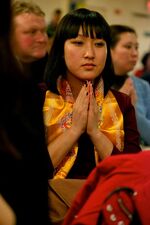
A meditating Lamanist woman in Ross.
A school Based out of Tibet, Lamaism has historically been the primary faith of the Mongol, Buryat, Manchurian and other Siberian Alaskans.In contrast to the Old World Alaskan Lamaism has begun to use Mongol in addition to Tibetan as a holy language. Due to early Kalmyk inroads into Alaska a certain portion of Native Americans are also affiliated with Lamaism. While other schools have emerged in recent years the Gelug school was traditionally the prominent School and still holds sway. Lamnists in Alaska have their own spiritual head independent from the spiritual head of the Tibet. However Lamnists in Alaska still give official acknowledgment to the Tibetan Dalai Lama as the reincarnation of the Bodhisattva of compassion but not as the political leader he is in Tibet. Recently with the rise of globalization the Alaskan Lamnists are working on forging closer spiritual ties with Tibet to enrich study and debate in Alaska. Since 1990 Lamnists from both countries have sent missions of monks and masters to each other to engage in group meditation and discussion in annual Lotus gatherings.
Chan and Zen
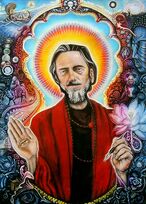
Painting of a Ukrainian Alaskan Zen teacher,
Chan and Zen are the most prominent variant of Buddhism for Chinese and Japanese Alaskans respectively. Until present times this kind of Buddhism was rarely seen outside of ethnic neighborhoods in coastal Alaskan cities. While previously exclusive to ethnicity in Alaska both Chan and Zen has been attracting interest from Russian Alaskans since the 1960's In beliefs both Chan and Zen prescribe meditation and enlightenment, both are famous for their riddles, some of which have become debated questions at public Alaskan universities. Cultural elements of Chan and Zen are found in Alaskan Tea and Karate.
New World Buddhism
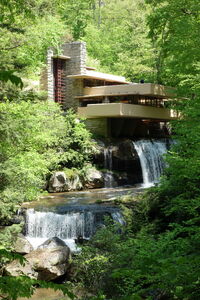
Little Step Meditation Center, Oregon Governate,
New World Buddhism is a unique result of cultural fusing and characterizes many beliefs and ideas native to Alaska. Arising from the 19th century writings of European, Asians and native Americans that met each other in Alaska. New World Buddhism emphasizes the Western Hemisphere. New World Buddhists believe there is innocence in the Americas because it is more pristine and untarnished, and was cared for by natives prior to colonization. As a result New World Buddhists believe nature must be kept as pure as possible and are fervent environmentalists. Native influence is confirmed by the use of totem poles, masks and native drums as objects of meditation in the Yakutat governate Teachings prescribe the merging between human and the wild as a facilitator for the reduction of suffering. Rivers and trees are particularly sacred in accomplishing personal peace. In contrast to other sects New World Buddhists are not as interested in elaborate temples but favor open spaces where laymen can reach consciousness. New World architecture tends to be minimalist and seeks to match any sacred structures with the surrounding environment. This is the case with Little Step Meditation Center in Oregon which is built to stream with existing river flow. New World Buddhism has been classified as "westernized" by Buddhists and secular intellectuals because of its public nature encouraging congregations of followers and preaching like Christianity. Controversially some New World priests have suggested the Buddha hood of Jesus Christ. However most major New World Buddhist organizations publicly reject any linking between Buddha and Jesus.
Organizations
Major Congregations
Enlightenment Church,
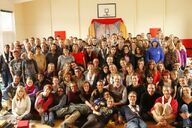
A youth Enlightenment Church delegation
The Enlightenment Church (Russian: просветление церковь, prosvetleniye tserkov), is the largest organization supporting New World Buddhism thought and belief. Founded in 1955, the church claims to have 120,000 members in Alaska and 150,000 total world wide. Beginning as a youth movement the Enlightenment Church opposed hierarchy in principal but has since developed central organization to maintain cohesion. Presently the structure is similar to the Orthodox Church but the Enlightenment Church is ruled by a counsel of eight ministers instead of a patriarchy. Each minister represents a part of the Noble Eigthfold Path Buddhist moral code. Sometimes the church has been termed an "activist" organization due to its congregations efforts to campaign against animal testing and fur coats. The issue of fur coats is controversial within the church as the fur trade still remains important to the Alaskan economy and consumers.
The Enlightenment Church is currently active in 30 countries and is present in every other country in North America. Notably the Enlightenment Church has a high percentage of white members.
Assembly of the Eastern Lama
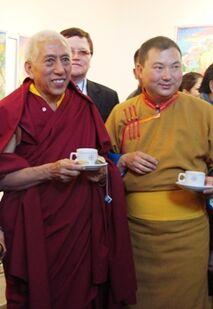
The current Kalmyk Lama (right) at a press conference.
The Assembly of the Lama (Russian: Ассамблея ламы, assambleya lamy, (Mongolian:Ламын Ассамблей,Lamyn Assamblyei) formally known as the Yellow Hat Dharma is the central organization for Lamnists in Alaska. Founded in 1885 as a linking of Kalmyk and other immigrant communities. Centered around the "Eastern Lama" , or the lama east of Tibet. Traditionally until the turn of the century most Mongolic newborns were registered with the Assembly. In times of domestic crisis the Assembly takes part in disaster relief for all Alaskans and coordinates with the Red Wheel. The Assembly holds a chain of schools, monasteries, temples, libraries a university and many charities. With 100,000 active members and 400,000 non active members the Assembly has been one of the most visible images of Buddhist and Asian Alaskans to general mainstream. The Eastern Lama, is one of the most influential of Asian Alaskans today appearing regularly by the televised media to give the "Buddhist" or mistakenly the "Asiatic" view on major events.
Gusku Society

Fire ritual in honor of a reincarnated enlightened chief, Sonoma Governate
The Gusku Society (Mongolian:Ламын Ассамблей, Gusku Niigem) emerged after early contact between the Pomo tribe and Kalmyk people. In recent years the Gusku Society has become more of a functioning organization among native elders, adapting certain Buddhist beliefs to their existing religion. Named after "Gusku" an old Pomo deity, the word "society" refers to loose organization of holy men among many native American tribes in Southern Alaska. From at least 1900 many of the Pomo have identified Gusku as being a god that became a Buddha. Old precolonial rites are still practiced under the guise of Buddhism.
Almost all of the members are native Alaskans with the exception of a few Kalmyks and Slavs. The Gusku Society also cooperates with sister branches from the Aleut, Inuit and Tinglit, all of which combine Buddhism with their separate native traditions. The Tinglit have become famous for their dozens of totem poles that combine Indian religion with Buddhist teachings, these totem poles are mostly seen outside of Gusku Society centers and have become a tourist attraction in their own right.
Schools
University of Manchicov
Founded in 1975 the University of Manchicov is a private non for profit university in Ross,Sonoma. The largest accredited Buddhist institution of higher learning in Alaska. Founded officially to facilitate a richer traditional Buddhist community and to equip that community for the modern economy, the University of Nemev has developed a global reputation for its medical and electronic development departments. Other prestigious programs are the departments of Buddhist Theology, Eurasian History, and Northeast Asian languages. Through the 1980's and 90's the University of Manchicov was the fastest growing college in the country superseding older Buddhist campuses. The University of Manchivcov is home to the largest library of Asiatic literature and history in the Americas.Today the university has become to be the most prestigious vehicle for entering the Buddhist Clergy. Hosting 15,000 undergraduates 20% of the student body is international. Adjacent to the University is a monastery with several hundred monks and graduate students reside. The University is named in honor Roman Manchicov, one of the first Buddhists to arrive in Alaska during colonial times.
Associated Symbols
Red Wheel
The Red Wheel is a symbol used by the International Association of Cross Societies the symbol was used for the first time by Alaskan Buddhist volunteers in several 19th century and 20th century conflicts. Inspired by the Dharma wheel volunteers began to use the symbol to reach wounded soldiers and civilians who had little familiarity with Christianity or Islam. While Buddhists had also used the Red Swastika before the 1940's this was entirely replaced by the Red Wheel to remove any possible confusion with the swastika of Nazism. Since World War II the Red Wheel is most commonly seen in nations without a Christian or Islamic background.
Demography
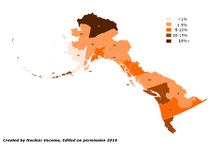
Concentration of Alaska's Buddhists by governante.From the 2007 Federal Census
As of 2017 federal Alaskan Census 9.9% of the Alaskan people (6,028,525) claimed to profess affiliation to Buddhism. While birthrates for Buddhist families have fallen in the past ten years a small growth rate has been consistent. In part this small increase is due from a small influx of converts and immigrants from Eurasia. Of these 63% stated they were of Asian Origin, 31% stated they were of white origin, 4% of "Indian" origin and 2% stated "other". Attainment of at least a bachelors or equivalent college degree has expanded to (74%) among adults.
As of 2007 federal Alaskan Census 9.7% of the Alaskan people (5,456,864)claimed to profess affiliation to Buddhism. Of these 61% stated they were of "Asian origin", 30% stated they were of "white" origin, 6% of "Indian" origin and 3% stated "other". A solid majority of adult Buddhist Alaskans (69%) had at least a bachelors or equivalent college degree, more educated than the average Alaskan population.
According to a study by the Kuzkin think tank Buddhists were solid Evergreen supporters until the 1960's on account of Anti-communism. Since the election of Vasily Kardash, Buddhists have gradually moved to the Movement for Peace and Freedom.
People
- Stepan Dzhobs (Степан Джобс) - New World Buddhist.
